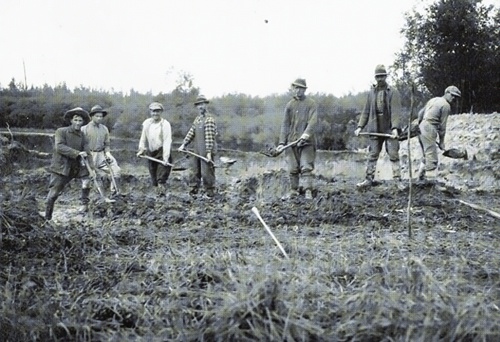 William Gallaway / Library and Archives Canada / PA-027507.
William Gallaway / Library and Archives Canada / PA-027507.
Abitibi's Little Russia
Translated by Melissa Bull, from Nouveau Projet Issue 11.
On August 17, 1946, fifty kilometres northwest of Amos, Quebec, in Abitibi, the members of the Christian Agricultural Youth planted a cross into the earth to signify they’d staked their claim on the township of Guyenne.
Colonizing a territory, of course, wasn’t a new phenomenon in North America, and European settlement took on considerable momentum after the 1929 financial crash. At its outset, Guyenne’s pioneers were certainly unaware that that they were about to put into place one of the most singular settler-utopian experiences in the history of the province.
Guyenne’s cooperative union was founded in 1947 by the village’s seventy men. Though the union was never completely independent of the government or the church, it quickly became indispensable. It distributed the lands, oversaw work and decreed the law of the collective.
Once a month, union members gathered in the church basement for their general assembly. The union elected their board of directors and assigned them their mandates. Together, they decided on the community’s global directions. All manner of subjects were discussed: clearing lands, housing, construction procedures—anything relevant to the settlement. From these meetings, small groups of six or seven people (chosen according to their location of residence) broke off and met at least once a week in order to discuss different issues at hand, including work and community relationships.
This operation required a certain dedication, particularly because the meetings sometimes ended late at night. One member told me that, in addition to their regular meeting, he had a directors’ meeting once a week, and, when it was urgent, two. Another told me he had seven meetings a week.
In the settlement, soon re-christened “Little Russia,” the needs of the collective came before the needs of the individual, and many of the community’s rules upheld this ideal. Salaries were decided upon by the teams of workers, who also decided on the division of labour, and on the rule that each person had to give 50 percent of their income to pay for their house. Private enterprise was forbidden, and workers needed to get permission in order to work outside of the settlement. Individual earnings were capped in order to avoid inequality. The consumption of alcohol was forbidden (this rule was only partially effective) and swearing was also banned (this rule was also ineffective).
The settlement’s division of labour between men and women might be shocking to contemporary observers. The meetings “were reserved for men,” says a female pioneer, “and … they didn’t tell us what was going on.” Another woman complains of having been forced to move “to a room far away” when meetings were held in her kitchen. Despite this, women organized amongst themselves, but mostly within religious institutions and without any real political power.
Ten years after the establishment of the settlement, the union members each occupied a house of such quality as to be the envy of neighbouring colonies. Guyenne also counted a church, a post office, a credit union and a general store among its establishments. The collective also extended into different circles of society, including stockbreeders and farmers, as well as into sports and leisure activities. Even the school functioned partially under the authority of the collective union, which determined the school teachers’ salaries.
The colony’s success attracted youth from the cities, and by 1966, Guyenne counted over five hundred inhabitants. But the imperatives of capitalism eventually caught up to them. In 1967, the union’s directors overrode the general assembly’s decision and created a forestry business, their first in twenty years. That same year, the province of Quebec granted several outside companies cutting rights on the collective’s territory. The settlement’s original way of life began to shift. In 1967, the province required a retrocession of the settlement’s lots in order to administer them directly. For better or for worse, Guyenne attempted resistance: in 1968 they started a petition asking that the rights of their small community be considered primary, ahead of those of large property owners.
Too conservative to be modern and too communist for capitalism, Little Russia was steamrolled by progress. Stuck between the conservative Grande noirceur policies of premier Maurice Duplessis and the secularizing Quiet Revolution of the sixties and seventies, it fell into the interstices of Quebec’s history—it now lives on only in the memories of those who built it.
Reprinted with permission from the publisher. Edited for clarity and concision.





